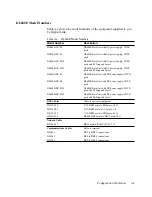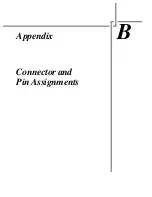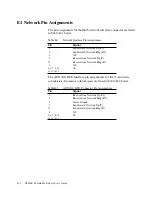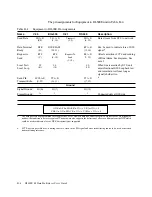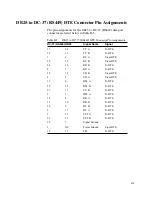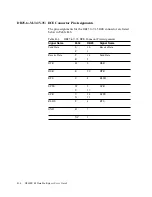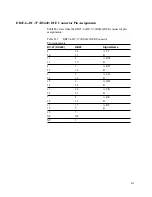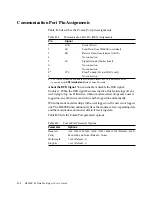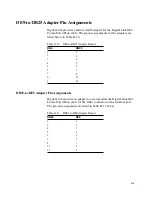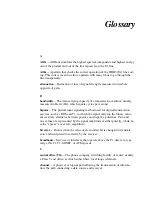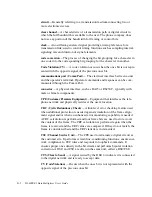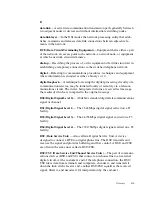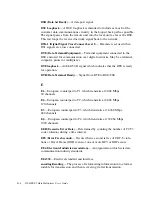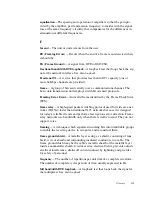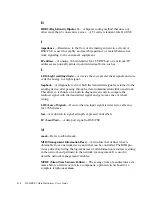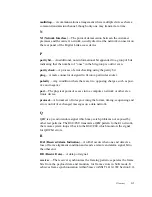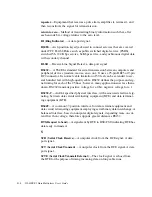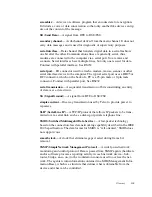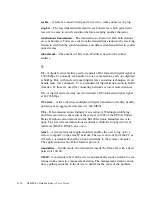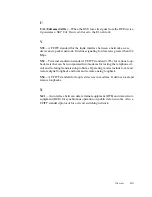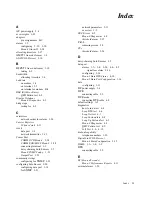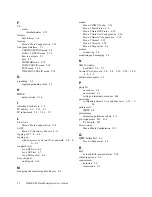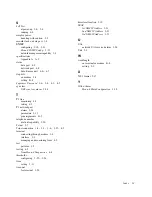
Glossary
G-3
D
data link
ÑA serial data communication transmission path, generally between
two adjacent nodes or devices and without intermediate switching nodes.
data link layer
ÑIn the
OSI
model, the network processing entity that estab-
lishes, maintains and releases data link connections between adjacent ele-
ments in the network.
DCE (Data Circuit-Terminating Equipment)
Ñ Equipment that is either a part
of the network, an access point to the network, a network node, or equipment
at which a network circuit terminates.
dial-up
Ñ Describing the process of, or the equipment or facilities involved in,
establishing a temporary connection via the switched telephone network.
digital
Ñ Referring to communications procedures, techniques and equipment
where information is encoded as either a binary
1
or
0
.
digital loopback
Ñ A technique for testing the digital processing circuitry of a
communications device; may be initiated locally or remotely via a telecom-
munications circuit. The device being tested returns a received test message,
the results of which are compared to the original message.
DS0 (Digital Signal Level 0)
Ñ A 64kbit/s standard digital telecommunications
signal or channel.
DS1 (Digital Signal Level 1)
Ñ The
1.544M
bps digital signal carried on a
T1
facility.
DS3 (Digital Signal Level 3)
Ñ The
44.736M
bps digital signal carried on a
T3
facility.
DS4 (Digital Signal Level 4)
Ñ The
274.176M
bps digital signal carried on a
T4
facility.
DSU (Data Service Unit)
Ñ Also called a Digital Service Unit. A device
designed to connect a
DTE
to a digital phone line. The
DSU
transmits and
receives the signal and provides buffering and ßow control. A
DSU
and
CSU
are often in the same unit, called a
DSU/CSU
.
DSU/CSU (Data Service Unit/Channel Service Units)
Ñ
T
he pair of communi-
cations devices
(DSU
and
CSU)
that connect an in-house line to an external
digital circuit. At the customer's end of the telephone connection, the
DSU/
CSU
takes data from terminals and computers, encodes it, and transmits it
down the link. At the receive end, another
DSU/CSU
equalizes the received
signal, Þlters it, and decodes it for interpretation by the end-user.
Summary of Contents for DL600E
Page 1: ...DL600EE1 DataMultiplexer User s Guide...
Page 2: ......
Page 12: ...xiv DL600E E1 Data Multiplexer User s Guide...
Page 14: ...xvi DL600E E1 Data Multiplexer User s Guide...
Page 20: ...xxii DL600E E1 Data Multiplexer User s Guide...
Page 26: ...1 6 DL600E E1 Data Multiplexer User s Guide...
Page 34: ...2 8 DL600E E1 Data Multiplexer User s Guide...
Page 102: ...5 26 DL600E E1 Data Multiplexer User s Guide...
Page 113: ...Appendix A DL600E Technical Speci cations...
Page 122: ...A 10 DL600E E1 Data Multiplexer User s Guide...
Page 123: ...Appendix B Connector and Pin Assignments...
Page 132: ...B 10 DL600E E1 Data Multiplexer User s Guide...
Page 144: ...G 12 DL600E E1 Data Multiplexer User s Guide...

